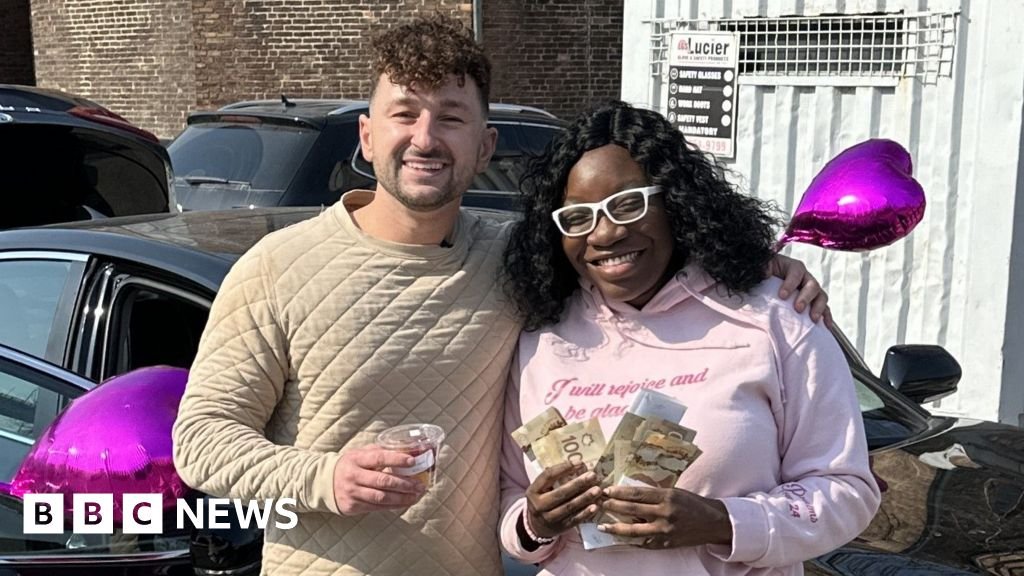Technology Reporter
Growing up, Samuel Weidenhofer struggled with his mental health after losing his aunt to suicide when he was nine, experiencing a speech impediment, and being bullied.
The trauma of it all made him want to end his own life, he says. When he was 17, he says he decided to turn to social media to spread a positive message.
“It started with simple things like giving people hugs in public and giving out roses and flowers and things that would make people smile,” says Weidenhofer, now 21, and living in Melbourne, Australia.
The difference was Weidenhofer filmed these acts and shared them across his social media accounts. The content spiralled and four years later, on Instagram alone he has amassed 1.7 million followers, where he can be seen surprising a person with a serious illness with money or a visit from a celebrity such as Jake Paul or Kristen Bell.
“I hope my videos inspire someone just a little bit,” he says.
Kindness content creators, or influencers as they’re often called, are increasing in numbers on social media.
Their approaches differ but a common tactic is to secretly film someone being given money, or tickets to a gig or sports match, or perhaps a free haircut.
“Kindness is cool,” says Zachery Dereniowski, 31, in the bio of his Instagram account where he has 5.7 million followers.
Mr Dereniowski’s videos often involve him telling a stranger that he is hungry and asking for food. When the person helps him out, he rewards the person with a gift, such as a laptop, or money.
“I suppose I want to really emphasise that every single person you come across has a story… and often the people who have the least give the most,” says Mr Dereniowski, who lives in Windsor, near Toronto in Canada, and started the account after giving free hugs to strangers.
Like many influencers, the kindness creators make money from adverts and sponsorship from the brands they work with. For example they might do a deal that involves giving away a particular brand’s product.
The videos of kindness content creators attract millions of views. Why are they so popular?
Saoirse Cleary, creative strategy director at marketing agency MG Empower, says they incorporate many of the elements that both social media algorithms and audiences favour: strong hooks, engaging captions, heartfelt narratives, and authentic, unscripted moments.
“Audiences are captivated by raw, real interactions with everyday people, offering an emotional connection from the comfort of their own screens. People increasingly seek positivity, authenticity, and emotional resonance in their online experiences, especially in spaces often saturated with entertainment-driven content.”
On the face of it the acts seem well meaning, so why do they attract criticism?
“”While these influencers may be genuinely generous… the generosity can sometimes feel performative, as it often serves as a way to attract more views, engagement, and ultimately financial reward, rather than purely altruistic motives,” says Ms Cleary.
Others go further, questing whether focussing on one, usually vulnerable person, is the right way to help out.
“I find the typical set up of many of the scenes quite disturbing,” says Hilda Burke, a psychotherapist, accredited with the British Association for Counselling and Psychotherapy.
She explains that the videos often involve someone being identified as “in need”. They are then asked for a favour. It might be spare money for a bus fare or help with something.
She argues the participant is being “lured” into valuing the needs of someone else, who appears richer, more highly than their own.
Only if they do that are they rewarded.
“I wonder what happens to those who don’t play the game?,” asks Ms Burke.
The influencers defend themselves by arguing that using social media this way is an effective strategy.
“I can raise more money, so I can help more people if I post it online,” says Mr Weidenhofer.
And how about filming people without their consent?
“If you are doing a video where you’re giving a hug to someone, if you tell them beforehand, it just takes away that authenticity,” says Mr Weidenhofer.
But he adds that these days he avoids filming people without consent as it was making him “feel weird”.
Sometimes large amounts of money are given to vulnerable people, which they might not be in a position to manage.
Mr Dereniowski realised that this might be an issue when he raised $240,000 overnight for a father and son who were living in their car.
After that, more thought goes into longer term help.
“We’ve started setting up financial advisors. We’ve started getting these people jobs. We’ve helped allocate the funds properly to pay off their debt, their car, helping them get a home and [pay their] rent,” he says.
If you have been affected by any of the details in this story, you can get help and support from the BBC Action Line.

